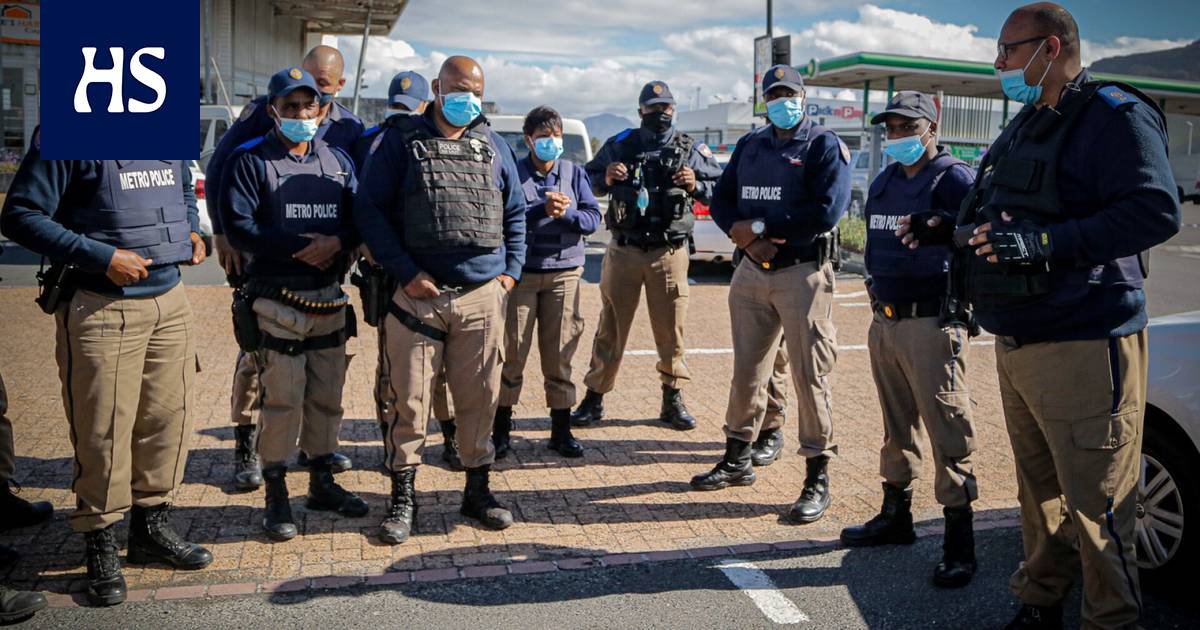Stopping, body search, home search. HS toured with drug and gang police in an area that is at the forefront of world crime statistics.
Capetown
Two a police car praises sirens howling in the street. Cars stop, and more than a dozen police officers jump out.
Police have bulletproof vests.
There is a group of young men on the street that they are approaching. The men are commanded against the fence.
We are participating in a special forces surveillance tour on the streets of Cape Town’s Lavender Hill. The suburb belongs to Cape Flats, which in turn is one of the most dangerous areas in South Africa. It is the world leader in statistics on drug, gang violence and homicide.
The GDTT responds to an alert in the Lavender Hill area.
Police conduct spot checks and body searches based on the alert they receive.
A small number of drugs and supplies are found in the search.
GDTT special forces move in areas where many other police patrols are reluctant to move.
Lavender Hill is being patrolled by the Cape Town Police Gang and Drug Task Force GDTT. Some of the basic police patrols refuse to work in the worst gang areas. In these areas, the police patrol always has at least two vehicles to ensure safety.
The purpose of the task force is to eradicate and prevent arms and drug trafficking and gang crime in particular. So-called spot checks are common: drug trafficking is constantly taking place on street corners, in the courtyards of apartment buildings, and especially after dusk inside homes.
Now police are seizing drugs and recording the men’s information.
This time, no one will be arrested.
GDTT: n master Sergio Demingo says his troops are in the Cape Flats area day and night.
Many locals are hoping for more police presence to make school trips for children safer, for example.
“
“We do what we can”
Harsh statistics also create some hope. Cape Town is the tenth most dangerous city in the world according to homicide statistics. The latest statistics show that there are more than 66 murders per 100,000 people in the city. However, according to authorities, homicides fell by less than seven percent in late 2021 compared to a year ago.
“I have been doing this work for twenty years. The human destinies and things I see almost daily make me sad and create a feeling of powerlessness. But we do what we can, ”says Sergio Demingo.
“But yes, this is taxing.”
PoliceT watching people standing and moving on the street.
We are next to a group of apartment buildings. Suddenly, police ran to the second top floor of a house. We follow.
The suspect, who is in a high-ranking position in one of the Cape Town gangs, had just run into the house.
The man saw the police and rushed into his apartment.
Special forces police follow the suspect to the second top floor of the apartment buildings.
We step into an apartment building that looks just like a regular home. The shelf in the living room has plastic flowers, ornaments and photo frames. The kitchen is clean. The beds in the bedrooms have bed linen, clothes and other accessories.
Police are asking the suspect to take off all their outerwear. They examine the suits and pockets of this clothing. We wait behind the door and hear hardening and commandments in Afrikaans.
Police are looking for drugs and guns in the structures, cabinets and shelves of the houses.
There are drugstores in the apartment, where children also live.
Residents have drugs that are seized by police for laboratory tests.
As we step down the stairs back to the special forces car through the doorways and windows peeking at the residents. Some children smile and blink.
Parents are worried about their children’s future as drug gangs recruit children and young people for gangs in the Cape Flats area.
Major some of the residents of Cape Flats belong to South Africa’s colored ones who have their own ethnic identity. There are nearly four million colored in South Africa, and the population is inherited from the descendants of the country’s indigenous koi, slaves in Southeast Asia, the Bantu population in southern Africa, and white Europeans.
The colored population once inhabited greener areas near the seashore and the slopes of Pöytävuori.
With apartheid, they were transferred to the lowlands of Cape Flats.
The Population Register Act of 1950 classified South Africans into four ethnic groups, and the Group Territory Act of 1950 assigned them separate settlements for which permission was required to cross internal borders.
In 1953, the country’s government still ordered people to separate hospitals, universities, and other public services. The Bantou Education Act of the same year introduced separate schools.
Over time, several additional laws restricted the movement of citizens. In practice, Africans were kept separate from cities unless they could justify their presence with a work permit.
Although regional segregation has diminished since 1994, in practice it is still strongly present. This is only seen by visiting Cape Town’s restaurants or vineyards, where the vast majority of customers are still only white.
Jennfier de Wee and Allen May would both like to move out of the Lavender Hill area.
Jennifer de Wee has lived in Lavender Hill for twenty years. He has wanted to be away for a long time, too long.
Two years ago, the worst happened. De Wee got a call: his 20-year-old son had been hit in a gang shooting. The ambulance went to take the boy to the hospital, and De Wee was left waiting for a call from his son’s condition.
The ambulance was called that the boy was dead.
De Wee and his neighbors Allen May watching children playing outside on the playground. They find that even infants and young people walking to school are caught in a crossfire during the shooting.
“Ammunition happens up to twice a week. Gangsters shoot each other. It’s not safe here, ”De Wee says.
In Lavender Hill and other areas of the Cape Flats, shooting ranges even break out near schools and playgrounds.
Allen May has been unemployed for several years. His wife has been in the city’s housing queue for safer areas for a decade. But the queues are long, and many are even weaker than Mayn and De Wee’s families.
The small unemployment benefits granted by the state are hardly enough to cover the basics. Unemployment in South Africa is currently the highest in the world at 35.3 percent. The soup kitchen in the area helps you get a hot meal during the day.
“It’s not good to live here. I keep my kids inside because it’s not safe outside. However, children would like to be outside, play and have fun, ”says May sadly.
Residents of Lavender Hill feel that the administration is not interested in what is happening in the areas inhabited by colored.
With the fall of apartheid, a so-called minority elite also formed in South Africa, but the gap between poor and rich has only widened.
Across the gulf are Neighborhoods like Lavender Hill. On the other side, prosperous areas are just a stone’s throw away, such as Marina da Gama next to Lavender Hill and Muizenberg.
Residents of Marina da Gama and Lavender Hill meet while shopping at the nearby Capricorn Shopping Center. Unlike many malls, Capricorn closes its doors at six o’clock. After dusk, the mall is not safe.
A few kilometers from the residential area of Lavender Hill is Muizenberg beach and a residential area where residents live a safe life.
From time to time there is an armored car in Capricorn’s yard.
“The Marina da Gama area is mainly inhabited by rich whites. We belong to a colored community and we are poor, ”says May.
“
“Gang members have plenty of weapons.”
Prosper residents of the area live in communities secured by private security companies, residents of the poor area resort to police surveillance. According to residents, it is not enough.
Murders are common in Lavender Hill. Authorities said there were 900 murders in the Cape Flats area in 2019 as a result of gang violence. That means 75 murders every month. A comparative crime analysis between 2017–18 and 2018–19 shows that the number of homicides in areas heavily controlled by gangs increased by nearly 12 percent.
Last year, Cape Town hired 1,000 new police officers due to increased crime. Some of the statistics now point in the right direction. However, residents of Lavender Hill say they have not benefited from the increase in police numbers.
“My daughter was shooting near school this morning. Police were informed, but they did not show up, ”May says.
“Gang members have plenty of weapons. They easily have male and armed power even against the police. ”
The police the presence in the Cape Flats areas is easily noticed. The next morning we are involved in another round of policing, this time with the LEAP group in the dangerous Kraaifontein area.
The LEAP is made up of thousands of police officers hired by the city to eradicate crime, especially in areas where there is not enough manpower.
From time to time, police park the car and continue on foot so residents can’t hear their approach.
In South Africa, the local population has a mixed attitude towards the police presence. Some need more police presence, others do not trust the police at all.
In Kraaifontein we are not allowed to get out of the car. The reason is a gang shooting that took place in the area a few days earlier. At least one person was killed, and at the time of the funeral the next day, police anticipated possible retaliation.
The names of the gangs are numbers: 26 ‘, 27’ and 28 ‘.
Police estimate that about a third of Kraaifontein’s residents are involved in gang crime in one way or another. You don’t like to talk to the police here. Some are afraid of gang reactions.
Searches on the streets often do not yield results, but inside homes it is different.
“Drugs and illegal weapons are found every day,” says one of the LEAP police officers
Police say the seemingly peaceful situation could suddenly become threatening. They need to be constantly awake and observe what is going on around them.
The adjoining apartment buildings, courtyards and street corners with crosses abound next to the car window. The crosses have been brought to the scene in memory of the victims of gang violence.
“There are a lot of them,” one of the police officers says.
#South #Africa #toured #drug #gang #police #area #forefront #world #homicide #statistics







